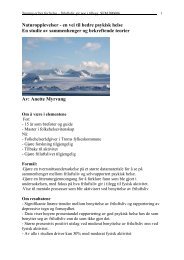Green Care: A Conceptual Framework - Frisk i naturen
Green Care: A Conceptual Framework - Frisk i naturen
Green Care: A Conceptual Framework - Frisk i naturen
Create successful ePaper yourself
Turn your PDF publications into a flip-book with our unique Google optimized e-Paper software.
conditions and interventions on people’s lives can be evaluated. Two<br />
treatments which are equal but have different consequences for the<br />
patient can be compared on the basis of how they affect the QoL. Patient<br />
experiences can be better understood using QoL- measures, for example,<br />
where there are adverse effects (McDowell, 2006).<br />
There are several conceptual models to measure health related quality of<br />
life (HRQoL). Although there is no unanimity among researchers as to<br />
whether the quality of life and health are distinct constructs (Smith et al,<br />
1999; Lercher, 2003), there is agreement, however, that quality of life is<br />
subjective and multidimensional in nature and includes both positive and<br />
negative dimensions of physical, psychological and social domains (The<br />
WHOQOL Group 1995). Smith et al (1999) concluded that when assessing<br />
the quality of life, greater emphasis is given to mental health than to<br />
physical state and that the pattern is reversed when health status is gauged.<br />
HRQoL measures are either health indexes or health profiles. Health<br />
indexes are global measures which summarize health in a single number.<br />
Profile measures have one or more separate domains and a total score for<br />
each domain is calculated independently. Generic measures are independent<br />
of the illness so they can be used when comparing the changes caused by<br />
different diseases to the quality of life. Disease specific measures focus on<br />
effects which particular diseases such as cancer may cause (McDowell,<br />
2006).<br />
The measures of HRQoL include other elements in addition to physical,<br />
mental, and social well-being. The relative balance between health issues<br />
and non health issues may vary by health status (Spilker and Revicki, 1996;<br />
McDowell, 2006). The EuroQol scale covers usual activities, the SF-36<br />
work and role performance, and WHOQOL covers spiritual well-being,<br />
transportation, and environmental factors, too (McDowell, 2006).<br />
QoL is a subjective outcome which is measured by standard scales and<br />
the problem is whether all the dimensions of QoL scales used are really<br />
important to the respondent. In some scales patient-specific items are<br />
added to increase the relevance of the scale. (McDowell, 2006). When<br />
patients are confronted with a life-threatening or chronic illness, they have<br />
to adapt to their situation. By changing internal standards, values, and<br />
conceptualisation of QoL, they accommodate their illness. The process is<br />
called response shift. (Sprangers and Schwartz, 1999) Response shift may<br />
91















